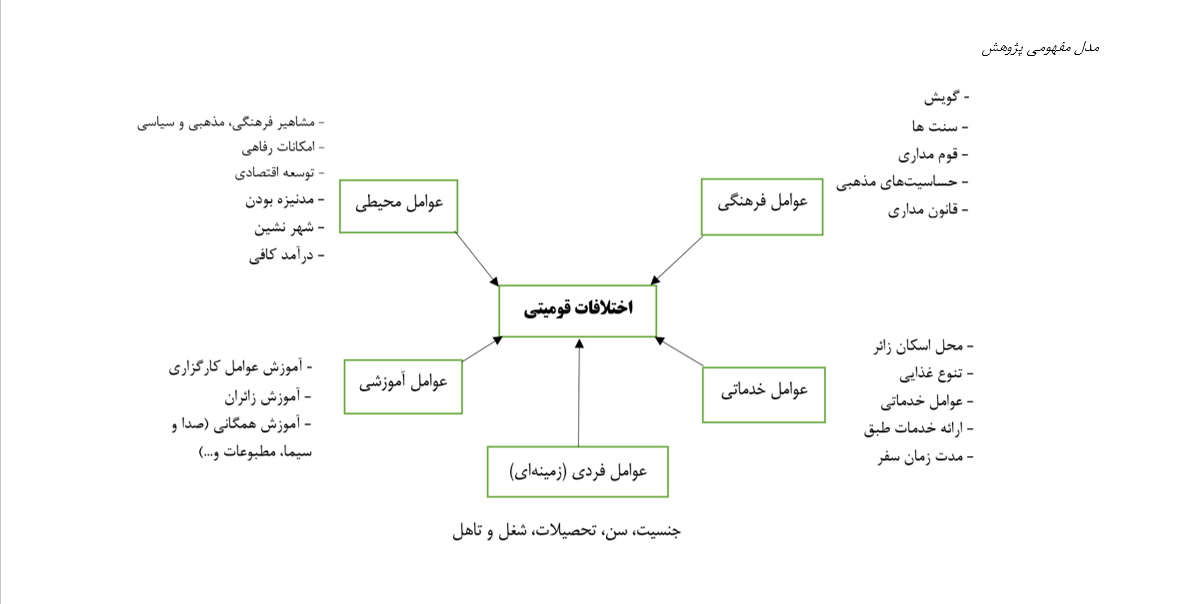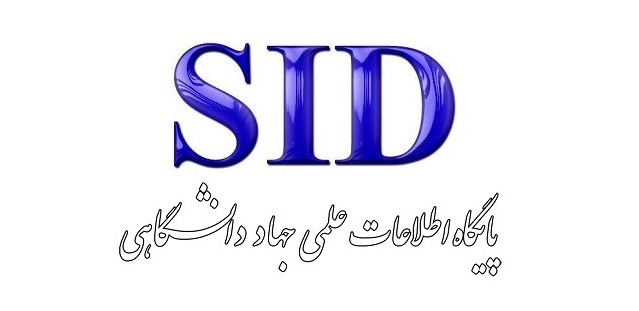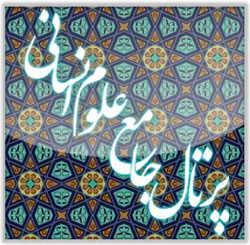Examining Social Factors Affecting Ethnic Conflicts in Pilgrimage Travels (Case Study: Pilgrims from Razavi Khorasan Province)
Keywords:
ethnic conflicts, social factors, pilgrim, caravanAbstract
The objective of the present study is to examine the extent of the impact of each social factor on ethnic conflicts in pilgrimage caravans in Razavi Khorasan Province, which is an applied research study. The statistical population of this study consists of pilgrims from Hajj Tamattu, Umrah, and Atabat pilgrimage caravans of Razavi Khorasan Province who were dispatched between 2013 and the end of 2022. Cochran's formula was used to determine the sample size, resulting in a sample of 384 pilgrims. The method for collecting the required data for this study was fieldwork, including referring to documents, books, credible websites, and databases in both Persian and English, followed by the development of a questionnaire based on theoretical foundations and provided indicators, which was distributed among the target population to measure the impact of social factors on ethnic conflicts. Using correlation coefficients and regression analysis, the type and extent of the relationship between the main concepts of the research were determined, and the obtained results indicate that, in order, educational, individual (background), cultural, service, and environmental factors influence the increase or decrease of ethnic conflicts among pilgrims. The findings from the analysis of the research data indicate that the influence of independent variables on the dependent variable (ethnic conflicts) is, in order, environmental factors, cultural factors, educational factors, service factors, and individual (background) factors, with environmental and cultural factors having a significantly greater impact on ethnic conflicts among pilgrimage caravan pilgrims compared to other factors. Among the sub-components of the independent variables, components related to the place of residence of the pilgrims, such as welfare facilities, economic development, sufficient income, modernization, urbanization, and cultural, religious, and political figures, have the highest and lowest impact on ethnic conflicts. This demonstrates that citizens’ access to material and economic facilities, especially sufficient income in their living environment, plays an effective role in reducing ethnic conflicts during pilgrimage travels. Furthermore, components such as religious sensitivities, traditions, dialect, ethnocentrism, and law-abidance affect ethnic conflicts, indicating that respect for the sacred, traditions, customs, and other ethnic features significantly reduces ethnic conflicts. Additionally, components such as the training of agency staff, pilgrim education, and public education (through radio, television, press, etc.) enhance pilgrims’ awareness levels and increase tolerance and accommodation with fellow travelers. Components such as the pilgrims’ accommodation, food diversity, service personnel, service provision according to contracts, and travel duration management, particularly during Hajj Tamattu, reduce ethnic conflicts among pilgrims. Finally, components such as gender, age, education level, occupation, and marital status of the pilgrims also affect the increase or decrease of ethnic conflicts.
Downloads
References
Abdullah, A. M. (2016). Investigating the Amount of Attention to the Components of Ethnic and National Identity among Kurdish and Azeri Students in Tehran Universities. Quarterly Journal of Strategic Policy Research, 4(16), 39-64.
Ahmadi, H. (2016). Ethnicity and Ethnicism in Iran: Myth and Reality. Ney Publications.
Alavi, S. M. S. (2006). Theorizing the Position of Ethnicities in the Policy Making of the Islamic Republic of Iran, with Emphasis on Kurdish Ethnicity
Amir, A., Irvani, Z., & Hajiani, E. (2015). A Comparative Study of Ethnic Identity in Iran and Lebanon. Iranian Journal of Applied Sociology, 26(2), 1-15.
Beheshti, S. S., & Rastegar, Y. (2013). Sociological Explanation of Social Tolerance and Its Dimensions among Iranian Ethnicities. Journal of Iranian Social Issues, 4(2), 7-358.
Farahmand, M., & Najafi, K. (2018). Investigating the Factors Affecting Inter-Ethnic Conflicts of Lak and Lore in Khorramabad. Journal of Strategic Research on Security and Social Order, 7(1), 43-64.
Farid, A., Habibi, R., Ghasemzadeh, A., & Sepahi Shadbad, H. (2013). Investigating the Difference in Ethnic and Racial Prejudices of Students Based on Religious and Linguistic Orientations. Conference on Ethnicity and Culture of Islamic Iran,
Islami, A. (2006). Ethnicity and Its Dimensions in Iran. Journal of Political Science, 9(34), 195-212.
Jalai Pour, H., & Nazar Abbasi, S. (2012). Ethnic Nationalism and Factors Affecting It (Case Study: Turkmen Students of Golestan Province). Publications of Tehran University, 1(1), 119-143.
Lahsai, A., Moghadas, A. A., & Taghavi Nasab, S. M. (2009). Investigating the Internal Factors Affecting Ethnic Host and National Identity among Arabs in Ahvaz. Journal of Applied Sociology, 20(33), 49.
Maghsoudi, M. (2001). Ethnicities and Cultural Identity of Iran. Nameh Pazhoohesh(22 and 23).
Mirzaei, S. A., & Eidi, M. (2020). Nationalism, Ethnicity and Ethnicism; A Case Study of Bojnourd City. Bi-Quarterly Journal of Cultural Social Research, 11(1), 125-159.
Mohammadzadeh, H., & Khani, S. (2018). Historical and Social Contexts Affecting Ethnic Division in Iran. Journal of Iranian Social Studies, 12(3), 125-147.
Moradi, A., Kavosi, I., & Ghyoomi, A. (2015). Designing a Model of Cultural Synergy in Iran. Quarterly Journal of Strategic Studies of Globalization, 6(15), 225-271.
Nik Bakhsh, B., & Vahidi, A. (2023). Second National Conference on Social and Psychological Harms with Emphasis on Behavioral Sciences.
Omidi, A. (2008). Comparing Structural Models of Management of Ethnic Communities: Lessons for Iran. Bi-Quarterly Journal of Program and Budget(106), 65-100.
Omidzadeh, G., & Omidzadeh, H. (2011). Journal of Social Sciences, Faculty of Literature and Human Sciences, University of Mashhad. Journal of Social Sciences, Faculty of Literature and Human Sciences, University of Mashhad, 8, 103-133.
Parchami, D., & Derakhshan, F. (2021). Investigating Social Gaps and Factors Affecting It (Case Study: Tehran). Journal of Applied Sociology, 32(3), 1-26.
Ragheb Esfahani, H. b. M. (1991). Mufradat Alfaz al-Quran. Dar al-Qalam - Al-Dar Al-Shamiya.
Sambanis, N. (2000). Partition as a Solution to Ethnic War. World Politics(4).
Serajzadeh, S. H., & Adhami, J. (2008). Investigating Ethnic Differences of Students in Terms of Activity in Cultural Centers of Universities. Quarterly Journal of Cultural Research, 1(2), 135-158.
Shamsi, K., & Eisazadeh, K. (2016). Management Strategy of the Holy Prophet of Islam (PBUH) in Order to Strengthen Unity among Ethnicities in the Early Islam. Journal of Habl al-Matin, 5(14), 94-105.
Torabi, Y. (2009). Policies of the Islamic Republic in Managing Social Diversities. Journal of Political Science, 5(1), 115-157.
Umana - Taylor, A. J., & Gomez, B. M. (2004). Developing the Ethnic identity scale using Eriksonian and social Identity perspectives. IDENTITY : An International journal of theory and Reserch. https://doi.org/10.1207/S1532706XID0401_2
Yousefi, A. (2001). Inter-Ethnic Relations and Its Impact on the National Identity of Ethnicities in Iran: A Secondary Analysis of a National Survey. Quarterly Journal of National Studies, 2(8), 13-42.
Yousefi, A., & Asgharpour Masouleh, A. (2009). Ethnocentrism and Its Effect on Inter-Ethnic Relations in Iran. Journal of Social Sciences of Tarbiat Modares University(11).

Downloads
Published
Submitted
Revised
Accepted
Issue
Section
License
Copyright (c) 2025 Ruhollah Shahebrahimi (Author); Manouchehr Pahlavan (Corresponding Author); Majedeh Gholipour (Author)

This work is licensed under a Creative Commons Attribution-NonCommercial 4.0 International License.







